

Humanity's New Cousin & An Ancient Giant Virus. Apes may be closer to speaking than many scientists think. Aug. 13, 2015 Koko the gorilla is best known for a lifelong study to teach her a silent form of communication, American Sign Language.
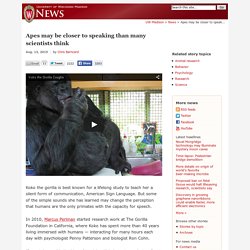
The World's Oldest Stone Tools Were Not Made By Humans. 02keilj comments on 1.2-million-year-old stone tool unearthed in Turkey. Engravings On A Shell Made 300,000 Years Before Humans Evolved. Humans have been controlling fire for at least 300,000 years. 7 Signs That Humans Are Domestic Animals. A Breakthrough in Our Understanding of How Intelligence Evolves. Evolution of early Homo: An integrated biological perspective. Did violence shape our faces? 9-Jun-2014 [ Print | E-mail ] Share [ Close Window ] Contact: Melinda Rogersmelinda.rogers@hsc.utah.edu 801-608-9888University of Utah Health Sciences (Salt Lake City) —What contributed to the evolution of faces in the ape-like ancestors of humans?
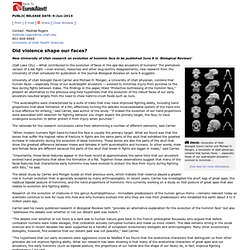
The prehistoric version of a bar fight —over women, resources and other slug-worthy disagreements, new research from the University of Utah scheduled for publication in the journal Biological Reviews on June 9 suggests. University of Utah biologist David Carrier and Michael H. Cooking may have driven human evolution nearly 2 million years ago. Neoteny. This diagram shows that the head becomes proportionately smaller and the legs become proportionately longer as humans mature.

This implies that proportionately large heads and proportionately short legs would be neotenous features for adults. An Evolutionary Whodunit: How Did Humans Develop Lactose Tolerance? : The Salt. Thousands of years ago, a mutation in the human genome allowed many adults to digest lactose and drink milk. iStockphoto.com Got milk? Ancient European farmers who made cheese thousands of years ago certainly had it. Ancient hominins definitely used fire at least a million years ago.
I present to you, the [true] evolution of human. : atheism. The mystery of the human intelligence explosion. Who is your old supervisor?
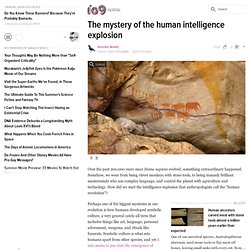
Paul Mellars. He was my college supervisor... technically I suppose he was my Adviser, when I was at Cambridge. I actually studied more with Ian Hodder and Sander Vanderliue (sp? It was a few decades ago now so spelling is probably wrong), as that I really studied Later European Prehistory. But I knew Paul and his Wife Annie much better on a personal level. Yeah I got the feeling that Paul was a cool guy from his writing — he seems very open to revising his ideas based on new evidence. Catching Fire: How Cooking Made Us Human. Catching Fire: How Cooking Made Us Human (2009)[1] is a book by British primatologist Richard Wrangham, published by Profile Books in England, and Basic Books in the USA.
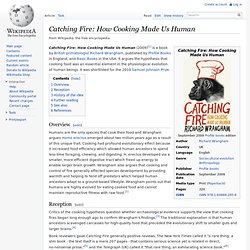
It argues the hypothesis that cooking food was an essential element in the physiological evolution of human beings. It was shortlisted for the 2010 Samuel Johnson Prize. Overview[edit] Humans are the only species that cook their food and Wrangham argues Homo erectus emerged about two million years ago as a result of this unique trait. Cooking had profound evolutionary effect because it increased food efficiency which allowed human ancestors to spend less time foraging, chewing, and digesting. Reception[edit] Book reviewers gave Catching Fire generally positive reviews.
History of the idea[edit] Homo erectus. There is still disagreement on the subject of the classification, ancestry, and progeny of H. erectus, with two major alternative classifications: erectus may be another name for Homo ergaster, and therefore the direct ancestor of later hominids such as Homo heidelbergensis, Homo neanderthalensis, and Homo sapiens; or it may be an Asian species distinct from African ergaster.[1][3][4] Some palaeoanthropologists consider H. ergaster to be simply the African variety of H. erectus.
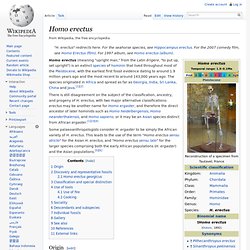
This leads to the use of the term "Homo erectus sensu stricto" for the Asian H. erectus, and "Homo erectus sensu lato" for the larger species comprising both the early African populations (H. ergaster) and the Asian populations.[5][6] Origin[edit] Homo erectus, Natural History Museum, Ann Arbor, Michigan The second hypothesis is that H. erectus evolved in Eurasia and then migrated to Africa. Discovery and representative fossils[edit] The find became known as Java Man. Current Anthropology, Vol. 25, No. 2 (Apr., 1984), pp. 151-168. How to Eat Like a Chimpanzee. Www.cameronmsmith.com/courses/EuropeanPrehistory2007/TheUpperPalaeolithicRevolution.pdf. Why Humans Give Birth to Helpless Babies.
Image: Jlhopgood, via Flickr.
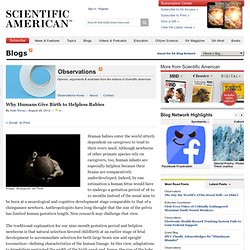
Are Shrinking Brains Making Us Smarter? - The human brain has decreased by about the size of a tennis ball over the past 30,000 years. - Evolution may be making our brains leaner and more efficient. - The same phenomenon can be observed in domestic animals compared to their wild counterparts.

Human brains have shrunk over the past 30,000 years, puzzling scientists who argue it is not a sign we are growing dumber but that evolution is making the key motor leaner and more efficient. The average size of modern humans -- Homo sapiens -- has decreased about 10 percent during that period -- from 1,500 to 1,359 cubic centimeters (91 to 83 cubic inches), the size of a tennis ball. Women's brains, which are smaller on average than those of men, have experienced an equivalent drop in size. These measurements were taken using skulls found in Europe, the Middle East and Asia. "I'd called that a major downsizing in an evolutionary eye blink," John Hawks of the University of Michigan told Discover magazine. How Mitochondrial Eve connected all humanity and rewrote human evolution. I remember reading about some controversy about the study in The Neanderthal Enigma.
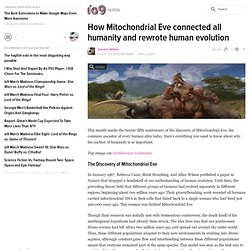
It seems that, at least as of the printing of the books, the sequence in which you put the information in would lead to different mitochondrial common points. There is also this: "The use of mitochondrial mtDNA to investigate human history is not without drawbacks. The rate of mtDNA mutation is not well known. A study by Parsons et al. (1997) found a rate 20 times higher than that calculated from other sources. In 1999 Awadalla et al. published a study suggesting that mtDNA could sometimes be inherited from fathers. Preserved bacteria reveal how we've been rotting our teeth for 7,500 years.
Geneticists Use Herpes to Confirm Ancient Human Migration Routes. 8 Incredible Facts You May Not Know About Human Evolution. Regarding number 5I don't think it's believed by anyone that they sailed across the Indian Ocean.

The prevailing theory, as far as I know, is that sometime around 80,000 years ago the crossed the red sea at it's southern end at a narrow channel now known as Bab-el-Mandeb which means "Gates of Grief". Back then the sea level was much lower so there were able to island hop across. Then they slowly migrated along the coast during a period of approximately 20,000 years (averaging about 1 mile per year), until they hit the general area of the Philippines and island hopped their way to Australia from there. The evolution of kissing. You MUST be kissing the wrong people. Naaaaah.
I think I just might not be that sensitive in the general mouth area. Just now, I chewed through my lip enough to draw blood and didn't feel a thing. The Mysterious Tool-Making Culture Shared by Crows and Humans. This skull may have just rewritten the book on human evolution. 15,000-year-old campsite in Texas challenges conventional story of American settlement. Congrats on getting your star. :)